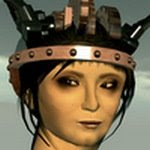On Werner Kurosawa, geodesic domes, and Green Phosphor’s novel work in Second Life
Posted by Bettina Tizzy
Years ago, a friend of mine who owned a large manufacturing centre sought to enclose the entire building complex within a geodesic dome, modelled after architect and inventor Buckminster Fuller’s lattice shell structures. His goal was not merely an aesthetic one, for it is said that such domes maximize efficiency in energy use for both heating and cooling, while being structurally strong. Fuller’s maxim: “Doing more with less.” That was my first introduction to the futurist, and I’ve admired many of his ideas ever since. As an irrelevant but nonetheless fascinating aside, virtual world residents who find their schedules unbearably stretched may take an interest in the fact that Fuller practiced Polyphasic sleeping for two years: only two hours a day via very short naps at regular intervals.
Fuller and Shoji Sadao’s U.S. Pavilion at the ’67 Expo in Montreal – Image courtesy of David Gomez Rosado
Fuller and Shoji Sadao dreamed of placing a climate-controlled geodesic dome over Manhattan – Photo courtesy of NeutralSurface
Buckminster Fuller’s domes were the first thing I thought of when I rezzed at Green Phosphor’s new facility in Second Life®, which is surrounded by an immense – even by SL standards – webbed rotating sphere. The effect is both elegant and highly dramatic.
If you click to enlarge, you will see that the spec at approximately the middle of this image is me, standing on a platform above the dome
Werner Kurosawa, the virtual architect
Created by Belgian architect Werner Kurosawa (aka Werner van Dermeersch), Green Phosphor is among the most handsome and livable virtual corporate campuses that I know of.
It was so not a surprise then when I visited Werner’s website and discovered various videos on Buckminster Fuller and links to the organization that bear the maverick’s name.
“Of course it is a tribute to him because he surpasses the ordinary, which every architect should do to have the right to use the title of architect. On the other hand, it was for my friend and client Tom Barman – lead singer of the Belgian group Deus - who used the “image” of Bucky as a reference to me when he wrote the song “The Architect” in their latest CD (look for the tape recorder on the bottom right).
In addition to his architectural work, Werner creates art installations, “from big to small.” From time to time he collaborates with his friend and composer Serge Verstockt on contemporary classical music and he also teaches Master classes in Art in Antwerp.
His Second Life name, of course, alludes to two of the greatest film directors of all time. He described a scene in Werner Herzog’s latest film, where an upside down image of a waterfall is seen in a drop of rain clinging to a leaf. He loves all films by Akira Kurosawa, but “Ikuru holds a special place in my heart.”
When Werner gets real, his predilections range from the university that Kasua Sejima built in Lausanne, the Lemoine house in Bordeaux by Rem Koolhaas – there’s also a great video about it here, via Gizmodo - which he believes to have been a milestone at that time, and the pyramid of Cheops in Giza.
Given the environmental advantages to the Green Phosphor dome, I expected Werner to answer affirmatively when asked if he considered ecological issues when building virtually. I was mistaken. “I consider environmental issues in Real Life. We would have to stop using computers and the Internet if we were to consider environmental issues in Second Life,” he said.
Most of the people in his life - including his Real Life clients - think he’s wasting his time in Second Life, “but I believe there is a big future ahead for the 3D Internet.”
Certainly the Real Life company Green Phosphor thinks so. “We produce the leading tool for visualizing data within virtual worlds,” said Ben Lindquist, the company’s CEO. “While our tool works in Second Life, Sun's Wonderland, and soon in Forterra's OLIVE, we have only one headquarters - the virtual headquarters that Werner Kurosawa built for us in Second Life.”
In this video, Lindquist explains how the company is using patent-pending technology to implement a virtual laboratory that has the potential of reducing the time and cost spent on drug development by up to 50%.
“I met Ben Lindquist at Brooklyn is Watching. I saw him building his first Graphs there and found them intriguing. When Green Phosphor rented half of the sim and put a prefab house there, I proposed that I would make a unique workplace in exchange for knowledge and a steady place to experiment next to BiW,” explained Werner.

Lindquist seems pleased with the arrangement: “The space that Werner created for us makes me happy when I move around in it; its design is clean yet comfortable; curvy yet solid. He took into consideration how the water in Second Life interacts with surfaces; reflections play upon the virtual cement and the view out into the rest of the sim is always interesting, thanks to the phantom prim structure Werner created to rotate around the entire island.”

So successful, in my view, was Werner’s rendering of Green Phosphor’s look and brand in Second Life, that I asked him if he’d collaborated with the company’s advertising or PR agency to bring it about. “No, but Ben has a nice father, Mark Lindquist, a famous sculptor whom I sometimes meet in Second Life and we have a lot of fun!” replied Werner.
Werner Kurosawa
Still, the people in Werner’s Real Life have a hard time understanding what he finds so compelling about virtual worlds. “People aren’t used to navigating in 3D and run around like flatlanders. I have the same experience with my work in Real Life when the scale gets really big or something is out of the ordinary,” he mused.
And Werner has been known to work on a very grand scale.
In Second Life: Werner's Twisted Tetrahedron Tower - 3,500m high 
In Real Life: Werner's Lightwall installation: 1,2 km across and 16km high. Photos courtesy of Werner Kurosawa
“They have difficulty grasping what is going on and it takes a long time for them to really see it. They aren’t used to flying around or even disconnecting what they are seeing from their bodies, especially when their view gets out of the XY plane. They get disoriented,” he continued. 

Z Apartments at Saturn - Photos courtesy of Werner Kurosawa
Werner explained how, soon after he graduated, he created some installations with plans and models and televised video of those models. “While they couldn’t read the plans and most could not read the models, everyone accepted television as ”real” (which it wasn’t). Perspective drawings where read correctly even when they weren’t drawn right.”
He is primarily interested in perception and perspective: “You have to keep in mind that the view you see in Second Life is calculated as a projection on a 2D surface of a “3D” world based on the same perspective model that was once made 500 years ago with a steady horizon at 1.65m high seen with one static eye. And we know that it isn’t “reality” but until now our society and products are based on that. We have two eyes moving in a moving head on a moving body.”
Werner freely admits that he was disgusted with Second Life after one or two hours the day he rezzed back in January of 2007. Some of his students had recommended it saying that it would really be his thing. He explained: “It was ugly. It had a much lower resolution than the 3D game engines I had used a lot before to do performances. The first engine I hacked was Duke Nukem back in1993. You had to pay for everything, and most avatars didn’t make contact with each other and those who did weren’t interesting at all. I returned many months later and it was more the social community that kept me going and finally introduced it as a tool. I was using the Unreal Engine 3 at that time with a lot more possibilities for 3D rendering.”

Hyperbolic Space - Photos courtesy of Werner Kurosawa
“Then, by meeting some very interesting people from all over the globe, I found I had a reason to stay inside. People started to ask me to sell them things I had made, which was more trouble than it was worth, so I always give my creations away. To this day I haven’t spent a penny in SL. And when you are creative and curious, you can find enough tools to make things yourself or trade with others. I do try to script my own things. SL gave me the need to program, which is also a new evolution in architecture with all the generative architecture going on. I try to learn with a lot of trial and a lot of error, but I do a lot of copy and paste from existing pieces of code wandering on the net. I see it as a tool and my experience with programmers is that they can program but that doesn’t mean they have ideas on what to create.”
So what does Werner wish that he could do the most that he cannot? Turns out he’d like to fly in Real Life... just like he does in Second Life.
You can visit Green Phosphor by teleporting directly from here.
Wednesday, July 8, 2009
Buckminster Fuller would have approved
Posted by
Bettina Tizzy
at
1:33 PM
![]()
Labels: 2D, 3D, architecture, art, Ben Lindquist, Buckminster Fuller, data visualization, geodesic dome, Green Phosphor, Second Life®, Werner Kurosawa, Werner van Dermeersch










2 comments:
Yay Werner!
Great update Bettina....and after I enlarged and saw you...I could then see you in the smaller pic.
Post a Comment